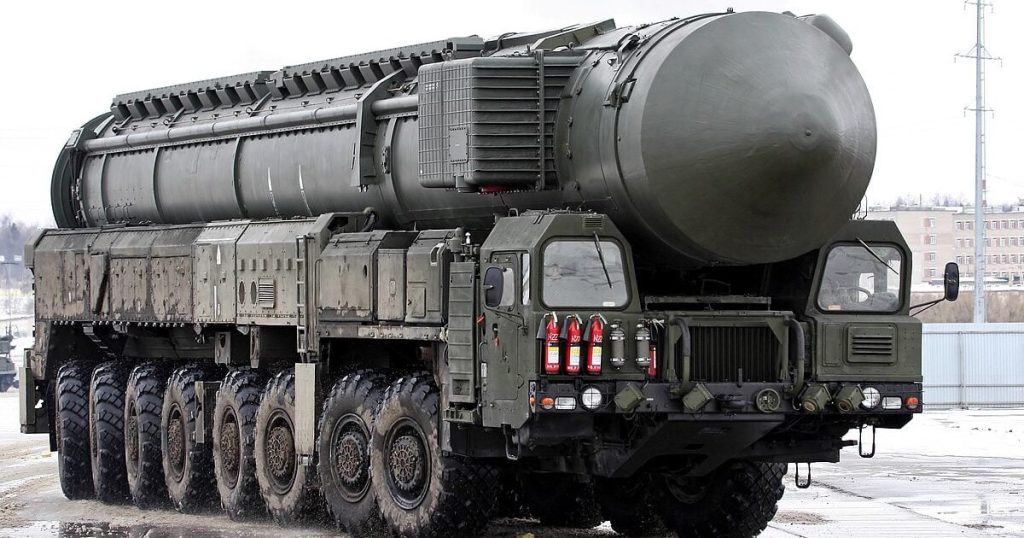RT-2PM2 Topol-M TEL with presumably Yars system transport-launch container during the first rehearsal for the Victory Day Parade at the training ground in Alabino. Photo by Vitaly V. Kuzmin, 19 March 2012. [CC BY-SA 4.0](https://creativecommons.org/licenses/by-sa/4.0/), via Wikimedia Commons.President Biden has decided to permit Ukraine to use US weapons to strike military targets inside Russia, where missiles are being launched from. This move is supported by NATO Secretary General Jens Stoltenberg. Until now, the US had disagreed despite Stoltenberg’s urgings, and several NATO members continue to voice their objections.
The decision is crucial for Ukraine’s chances of winning the war. However, it marks an escalation, bringing the US closer to conflict with Russia, the world’s largest possessor of nuclear warheads. A video released by the Russian government warns that by enabling Ukrainian strikes inside Russia, the West has revealed its “true motive.” The Moscow claims that these weapons are not for defense but are intended to strike civilian infrastructure inside Russia.
Putin told reporters in Tashkent that constant escalation could lead to dire consequences in Europe and the United States. He warned Western leaders that their decision was dangerous and could trigger a global conflict. Specifically, he said that sending French troops to Ukraine would be a step too far. Additionally, he ominously stated that some European countries have small landmasses but dense populations. Regardless of where one stands on the Ukraine war or whether the US and NATO should be involved, the Kremlin is correct in saying that each successive escalation brings the world closer to a global conflict.
On March 22, 2024, Russia declared war on Ukraine. While major media outlets reported this escalation, it didn’t receive the attention it deserved. A declaration of war is a critical step, changing Russia’s internal rules of engagement and allowing for broader military actions. In Russian military thinking, “war” is the most intense form of conflict, whereas “special military operations,” as the Ukraine conflict was previously classified, are seen as less intense on a spectrum of warfare. This declaration sets the stage for a stronger response to any foreign interference.
In a speech just before the declaration of war, Putin stated, “Strategic nuclear forces are in a state of full readiness for guaranteed use.” The mention of nuclear weapons is concerning, especially now that war has been declared. The “Basic Principles of State Policy of the Russian Federation on Nuclear Deterrence,” approved by President Vladimir Putin in June 2020, outlines Russia’s nuclear policy. According to this policy, Russia reserves the right to use nuclear weapons in response to the use of nuclear or other weapons of mass destruction against it or its allies. However, nuclear weapons may also be used in response to conventional aggression that threatens the very existence of the state. So, the definition of a threat or the threshold for the use of nuclear weapons is both ambiguous and subjective, meaning the Ukraine war itself, direct attacks on the Russian homeland, or foreign intervention could be enough to trigger a nuclear response.
Now that the threat of nuclear war has increased, there is a heightened risk of global conflict, as the US and other Western nations are contractually obligated to become involved. Putin’s invasion of Ukraine violates the Budapest Memorandum, a 1994 agreement between Ukraine, Russia, the United Kingdom, and the United States. This memorandum provided security assurances to Ukraine in exchange for its agreement to relinquish its nuclear weapons to Russia. Ukraine sought legally binding guarantees for its protection in case of invasion, but the US did not agree to such terms. Instead, the US, UK, and Russia provided politically binding assurances to respect Ukraine’s independence, sovereignty, and existing borders.
The Memorandum on Security Assurances in connection with Ukraine’s accession to the Treaty on the Non-Proliferation of Nuclear Weapons, also known as the Budapest Memorandum, states, “The United States of America, the Russian Federation, and the United Kingdom of Great Britain and Northern Ireland reaffirm their commitment to Ukraine, in accordance with the principles of the CSCE Final Act, to respect the Independence and Sovereignty and the existing borders of Ukraine.”
China and France also made similar assurances but did not sign the Budapest Memorandum. On December 4, 1994, China issued a statement reaffirming its commitment to Ukraine’s sovereignty, independence, and territorial integrity. China expressed its support for the security assurances provided by the Budapest Memorandum signatories and declared its respect for the principles of the UN Charter regarding non-aggression and non-interference in internal affairs. However, China has violated this promise by aiding Russia’s war in Ukraine.
France issued a similar statement on December 5, 1994, echoing the sentiments of the Budapest Memorandum. France emphasized its commitment to Ukraine’s sovereignty and territorial integrity and reiterated the importance of respecting international laws and principles, particularly those enshrined in the UN Charter.
The declaration of war is an escalation. The low threshold for Russia’s use of nuclear weapons could easily be triggered by increased involvement from foreign powers or by Ukraine striking the Russian homeland. This is not to say that Ukraine is wrong for defending itself or for attacking the Russian homeland, nor is it a refutation of the US, NATO, or other nations coming to Ukraine’s aid. It is simply a reminder that the US and the West must be prepared for a full-scale war with Russia, including the possible use of nuclear weapons.
In his speech to the Russian people, Putin said about the West, “Everything that they are coming up with now, how they are spooking the whole world—all this really threatens a conflict with the use of nuclear weapons, and therefore the destruction of civilization.”
The post Ukraine Conflict: Path to Nuclear World War appeared first on The Gateway Pundit.







